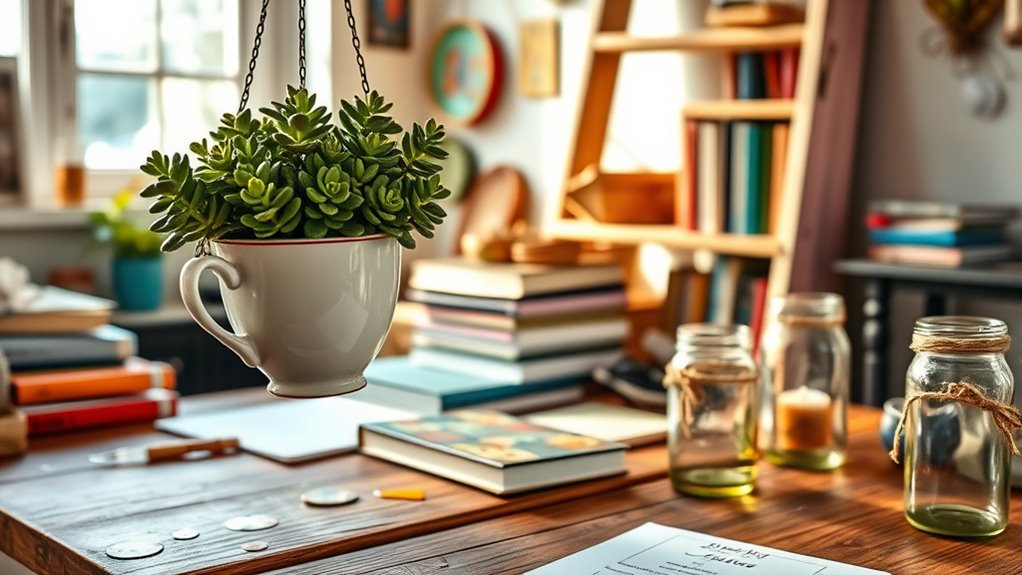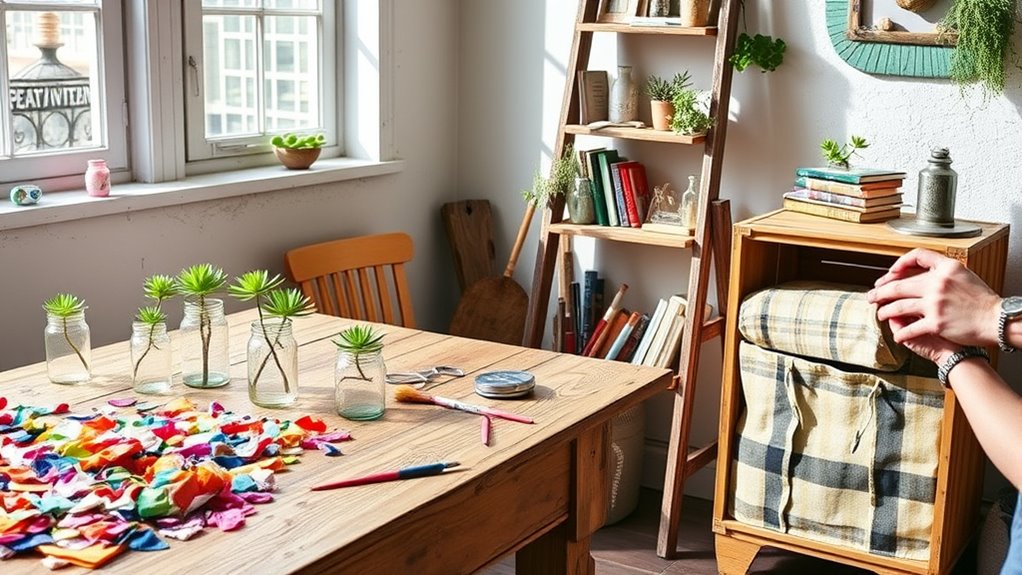Upcycling DIY projects let you transform household items into stylish, eco-friendly decor and useful solutions. You can turn old jars into storage containers, repurpose tin cans as planters, or craft bags from worn-out T-shirts. These projects reduce waste, save money, and inspire creativity. By using simple techniques and natural materials, you make a positive environmental impact while adding personal style to your home. Keep exploring to discover more innovative ways to give new life to everyday items.
Key Takeaways
- Transform old jars into stylish storage containers by painting or wrapping them with twine.
- Convert tin cans into decorative planters with added drainage holes and colorful paint.
- Repurpose worn-out T-shirts into reusable shopping bags through simple sewing or knotting techniques.
- Turn vintage jeans into rustic wall hangings or storage pockets, combining creativity with sustainability.
- Use discarded magazines and cardboard to create eco-friendly wall art and collages for personalized decor.

Upcycling DIY projects are a creative way to breathe new life into old or unused items while helping the environment. Instead of tossing out things you no longer need, you can transform them into something useful or beautiful through recycling art and eco friendly crafts. This approach not only minimizes waste but also sparks your imagination, allowing you to craft unique pieces that reflect your personality and style. Whether it’s turning an empty jar into a chic vase or repurposing worn-out furniture into eye-catching decor, upcycling offers endless possibilities for sustainable creativity.
Upcycling transforms old items into stylish, eco-friendly decor, sparking creativity and reducing waste.
When you immerse yourself in recycling art, you’re essentially giving discarded materials a second chance. For example, old magazines and cardboard can become colorful collages or wall art, showcasing your artistic talent while reducing landfill waste. Using eco friendly crafts means choosing environmentally conscious methods and materials, like natural paints or biodegradable glues, ensuring your projects are as sustainable as they are attractive. These practices help you cut down on harmful chemicals and unnecessary packaging, making your crafts safer for both the planet and your home.
One simple way to get started is with household items you already have. Old glass jars can be painted or wrapped with twine to create stylish storage containers, perfect for organizing your kitchen or bathroom. Instead of buying new decor, you could upcycle tin cans into planters by adding drainage holes and colorful paint. This not only saves money but also reduces the demand for new products, cutting down on manufacturing waste. Plus, these projects tend to be quick and straightforward, so you can enjoy the satisfaction of completing something useful in just a short time.
Another avenue to explore is transforming textiles and clothing. Old t-shirts can become reusable shopping bags, or worn-out jeans could turn into a rustic wall hanging. With a little sewing or knotting, you create functional items that serve a purpose and look great. These eco friendly crafts emphasize the importance of reusing materials rather than discarding them, helping you develop a more sustainable lifestyle. Plus, the more you experiment with different materials, the more creative and resourceful you’ll become.
Ultimately, upcycling DIY projects empower you to reduce waste and promote environmental awareness while expressing your creativity. Recycling art and eco friendly crafts are about seeing potential in what others might throw away. When you choose to upcycle, you’re making a positive impact by conserving resources and inspiring others to follow suit. It’s a fun, rewarding process that transforms old household items into new treasures, all while supporting a healthier planet. Incorporating sustainable practices into your craft projects can further enhance their eco-friendly benefits and inspire eco-conscious living.
Frequently Asked Questions
What Are the Best Tools for Upcycling Household Items?
You’ll need some essential tools for upcycling household items, starting with power tools like a drill, sander, and jigsaw for cutting, shaping, and sanding. These make the process faster and easier. Don’t forget to choose the right paint types—like chalk or spray paint—to give your projects a fresh look. Having a variety of brushes and primers also helps achieve a smooth, professional finish, making your upcycling projects truly stand out.
How Do I Choose Safe and Eco-Friendly Materials?
Choosing safe, eco-friendly materials is like picking the greenest leaves on a tree. Focus on recycling vs upcycling to minimize waste and prioritize non-toxic, biodegradable options. Look for labels like FSC or organic certifications, and avoid plastics with harmful chemicals. By selecting sustainable materials, you’ll enjoy environmental benefits while creating beautiful, safe projects. Your mindful choices help protect the planet and inspire others to follow suit.
Can Upcycling Be Done With Children?
Yes, you can definitely do upcycling with children. Crafting with kids is a fun way to teach them about sustainability and creativity. Just make sure to prioritize upcycling safety by supervising their activities and choosing non-toxic, child-friendly materials. Keep sharp tools out of reach and set clear boundaries. With these precautions, upcycling becomes an engaging, safe, and educational activity for you and your little ones.
How Much Time Does a Typical Upcycling Project Take?
A typical upcycling project usually takes anywhere from 30 minutes to several hours, depending on its complexity. You’ll find that the recycling benefits are worth the effort, but be prepared for some upcycling challenges like measuring accurately or finding the right materials. The more you practice, the quicker you’ll get, turning household items into creative treasures while helping the environment.
Where Can I Find Inspiration for New Upcycling Ideas?
You can find inspiration for new upcycling ideas by exploring recycling communities online, where members share creative projects and tips. Design blogs are also great for fresh ideas, showcasing innovative ways to repurpose household items. Join social media groups focused on sustainability and upcycling, and attend local workshops or craft fairs. These sources will spark your creativity and help you discover endless possibilities for upcycling.
Conclusion
So, next time you’re about to toss that worn-out jar or tired t-shirt, remember—you’re just a master upcycler in disguise. Why buy new when your trash can become treasure with a little ingenuity? After all, who needs a landfill when you can turn everyday clutter into art? Embrace your inner DIY hero, because saving the planet never looked so stylish—and slightly sarcastic. Happy upcycling, you eco-warrior, you!









